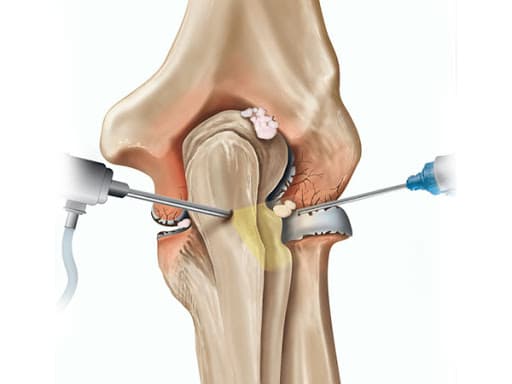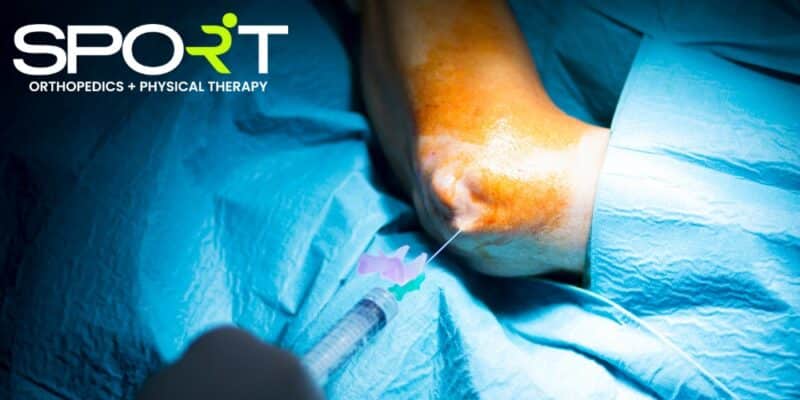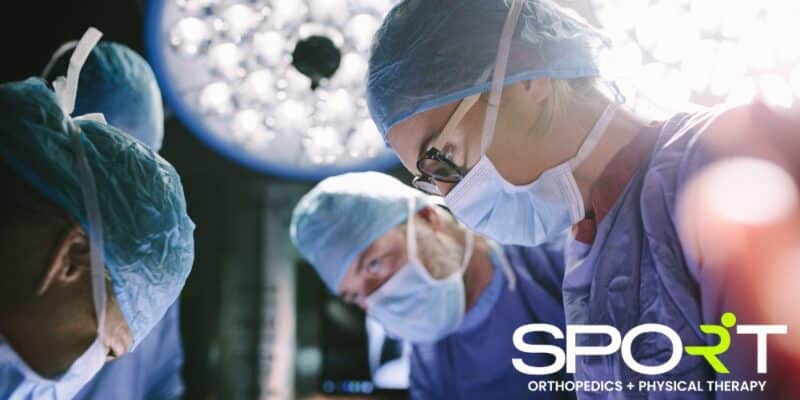Elbow Arthroscopy in Dallas & Frisco, Texas
Arthroscopic Elbow Surgery
Frisco & Dallas Elbow Pain Specialists
At SPORT Orthopedics + Physical Therapy, we offer top-of-the-line treatments and elbow surgery for patients experiencing a wide variety of joint issues. Our locations in Dallas and Frisco also offer the best in physical therapy either for non-surgical approaches or as an addition to your surgical treatment. If you suffered an injury or have a joint condition in your elbow, our experts have extensive experience treating all types of elbow joint issues with elbow arthroscopy.
To schedule an appointment with an experienced and widely-regarded orthopedic surgeon, please call SPORT today at 469-200-2832. If you’re searching for the “best orthopedic doctor near me,” you’ve come to the right place. Our elbow specialists are some of the best in the business when it comes to diagnosis and treatment.
Frisco & Dallas Elbow Pain Specialists
The elbow is a complex joint in the body which allows the bending, straightening, and rotation of the forearm. Three bones form this essential part of the body: the humerus, the ulna, and the radius. Articular cartilage covers the surface of these bones where they meet to form the elbow joint. This smooth substance acts as a cushion and protects the bones from forces applied to the joint.
Additionally, a thin, smooth tissue called the synovial membrane covers the rest of the surfaces within the elbow. Healthy elbows make their own fluid that lubricates the cartilage, which then eliminates almost all friction as you move your arm. When people experience issues with their elbows, they may experience a loss of mobility, pain, or inflammation. In order to treat these conditions, patients often undergo elbow arthroscopy surgery.

What Is Arthroscopic Elbow Surgery?

Arthroscopy is a form of minimally invasive surgery employed by experienced orthopedic surgeons to treat injured or diseased joints. Elbow arthroscopy involves the use of fiber optics and a very small camera inserted through small incisions or portals into the elbow joint. The surgeon views the inside of the elbow via a television monitor while they insert tiny surgical instruments into the “portal.”
Arthroscopy allows the surgeon to avoid damaging the surrounding soft tissue of the elbow, as well as evaluate the joint more thoroughly. Generally, surgeons take MRIs and X-rays of the joint to obtain information about the tissues surrounding the bones. This information allows surgeons to view irregularities, as well as decide where to place portals for the surgical instruments.
When Is Elbow Arthroscopy Recommended?
Our orthopedic surgeons recommend elbow arthroscopy for a variety of reasons, including pain, stiffness, or loss of motion in the joint. Common diagnoses include the following:
- Adhesions: These are bands of soft tissue which block motion. They usually result from previous injury to the elbow, like a fracture.
- Contractures: These are conditions in which the muscles and tendons abnormally contract. This limits the range of motion. Fragments of bone or cartilage sometimes break loose, which cause pain, catching, or locking of the joint.
- Arthritis: This disease wears away at the cartilage of the joints, which prevents the joints from smoothly gliding against each other during movement.
- Tennis Elbow: This involves painful tendonitis on the muscles of the outer part of the elbow.
- Osteochondritis Dissecans (OCD): This involves a lack of blood flow to a certain part of the humerus bone. Generally, this issue develops in teenagers or older children who frequently participate in sports involving throwing or bearing weight on the upper body.
- UCL Tear: This occurs after the ligaments in the elbow suffer significant wear and tear. It is similar to an ACL tear in the knee, but it occurs in the elbow.
Why Is Elbow Arthroscopy Performed?

Orthopaedic surgeons typically perform arthroscopy on elbow, shoulder, and knee joints for two reasons: diagnosis and treatment. Arthroscopy is a minimally-invasive surgical procedure that allows surgeons to see inside the joint and take biopsies without resorting to open surgery. In fact, many cases involve surgeons both diagnosing and treating the issue in one surgery.
They can use elbow arthroscopy to confirm their diagnosis, then treat the elbow joint as needed. Some more specific uses for arthroscopy include removing loose bodies in the elbow joint, removing thick scar tissue, improving the range of motion, and treating certain elbow injuries. Keep in mind that arthroscopic surgery is not always an option. Sometimes, when there is extensive damage in the elbow joint, open surgery is still necessary.
Who Is a Good Candidate for Elbow Arthroscopy?
Typically, the best candidates for arthroscopy only have mild to moderate elbow conditions, such as osteoarthritis. However, a multitude of conditions and injuries of the elbow joint could benefit from elbow arthroscopy. Below, we include a non-exhaustive list of conditions that arthroscopy could be used to treat or diagnose.
- Removal of loose bodies in the elbow joint
- Ulnar nerve entrapment
- To reduce or prevent joint stiffness
- Ulnar collateral ligament injuries
- Valgus extension overload syndrome
- Lateral epicondylitis
- Nerve injury or damage
- Age-related wear and tear
- Radial nerve entrapment
- Inflammatory arthritis
- Removal of bone fragments
In general, we attempt to remedy painful symptoms and elbow problems with non-surgical options before considering arthroscopy of the elbow. We may prescribe pain medicine, schedule physical therapy sessions, or try elbow injections to relieve pain. However, if these options fail to help with your joint stiffness and pain control, your orthopaedic surgeon may consider elbow arthroscopy.
Is Elbow Surgery Painful?
Before elbow arthroscopy, patients either receive general or localized anesthesia. General anesthesia results in patients sleeping through the procedure, and they feel no pain. Local anesthesia, coupled with medicine, helps patients to relax while the area to be operated on is numb to pain. Many people experience some degree of pain or discomfort after any surgery, but our orthopedic surgeons will likely prescribe pain medication to help ease that pain.
Following your orthopedic surgeon’s orders about limited movement and postoperative care is imperative to avoid aggravating or disturbing the area. In some cases, applying ice helps with swelling or soreness of the area. If you experience an abnormal amount of pain after your surgery, contact your doctor immediately. Other reasons to call your doctor include fever, chills, severe pain, loss of feeling in the arm or hand, redness, swelling, or draining from the incisions.
How Do I Prepare for Elbow Arthroscopy?

After consulting with one of our orthopedic surgeons and determining that elbow arthroscopy is the way to go, you will work together to develop a treatment plan. This plan will ensure that you achieve the best results possible after your surgery, barring any unavoidable complications. Preparing for surgery both mentally and physically is the first step to full recovery. Below, we list the steps to take the day before your surgery:
- You cannot drive for at least 24 hours after the surgery. Arrange for someone to take you to and from the hospital.
- Avoid eating or drinking anything before your surgery as your doctor directs you.
- Sometimes, our orthopedic surgeons recommend that you engage in physical therapy or targeted exercises to build muscle around the area.
- Take all medications as directed. Some medications should not be taken for a certain period of time prior to surgery, as they might prevent blood clotting.
- Have someone available to help with everyday tasks after your surgery. Anything that you need two hands to do will require help from someone else.
Do They Put You to Sleep for Elbow Surgery?
Usually, yes. This is done using general anesthesia, which both puts you to sleep and prevents you from feeling pain. In most cases, staff members speak with you about your anesthesia options. In a few cases, they may find that regional nerve block injections are the best option for you. While it does numb the elbow area, the numbing effect lasts for a few hours after the procedure. This is the principal reason why this method is rarely used. The other reason is that, with numbed nerves, your surgeon cannot perform a nerve examination after the procedure’s completion. Thus, general or regional anesthesia is usually the way to go.
What Happens During Elbow Arthroscopy?
It is incredibly important for orthopaedic surgeons to explain each procedure before they perform them on patients. This ensures that patients can be as prepared as possible before they undergo a procedure. In this section, we outline the full process of elbow arthroscopy.
- Prior to the procedure, you will be evaluated by both your primary care physician and an anesthesia provider to ensure that you are not at risk for complications. We typically opt for general anesthesia for arthroscopy, but in rare cases, we use regional nerve block injections.
- Once you are in the operating room, we will use surgical markers to draw where certain structures are, as well as where we will place the small incisions for portals. These portals will be used for inserting the tiny camera (arthroscope) and the small surgical instruments. Examples of certain specific portals include the proximal lateral portal, anterolateral portal, posterolateral portal, and anteromedial portal.
- Once the incisions are made, your elbow will be filled with fluid. This allows the surgeon to see the structures of your elbow more clearly, and it also lessens the chance of damaging the soft tissues surrounding the area. The surgeon will then identify the problem area and begin the surgical treatment process.
- When the procedure is over, your incisions will be closed either with skin tape or stitches. Your surgeon will also perform a careful nerve examination to ensure that none of your nerves have been damaged in the process.
What Are the Risks and Potential Complications of Elbow Arthroscopy?
Most patients have no problems with their elbow arthroscopy. However, as with any surgery, there are potential risks and complications involved. Below, we list potential complications of this procedure:
- Elbow arthroscopy has a slightly higher risk of nerve irritation and infection than shoulder or knee arthroscopy.
- Excessive bleeding
- Blood clots
- Damage to blood vessels
- Damage to nerves
What Happens After Elbow Arthroscopy?

Arthroscopy is typically performed as an outpatient procedure. Once your orthopaedic surgeon has finished the procedure, you will remain in the recovery room for a few hours. You will be monitored by medical professionals to ensure that everything goes smoothly, as well as to provide pain medication if needed. Depending on the extent of the surgery, your elbow will need weeks to heal properly. Be sure to speak with your surgeon about how best to care for your elbow and upper arm after surgery.
How Long Does it Take to Recover From Arthroscopic Elbow Surgery?
Every patient has a somewhat different condition and procedure, so recovery times vary from person to person. For minor repairs and procedures, your surgeon might not even have you wear a split. After a short period of rehabilitation, you will likely see your range of motion return. Returning to school and/or work is possible after a few days of recovery from the procedure.
For more complicated procedures, more recovery time is necessary. Even though the incisions are very small for arthroscopy, it is possible to repair extensive elbow damage. For repairs of extensive damage, we sometimes see recovery times of up to several months. While this is a slow process, it is extremely important to allow your body to heal properly. Always follow the recommendations of your surgeon, as well as your rehabilitation plan. This is key to as successful an outcome as possible, and will help prevent further damage to the area.
How Soon is the Follow-Up After an Elbow Arthroscopy?
Follow-up appointments, like the procedures themselves, vary from patient to patient. Your orthopedic surgeon will work out a plan to monitor your recovery and give you tips on how to effectively manage any pain you might have. Go to all follow-up appointments and adhere to your orthopedic surgeon’s recommendations. In certain cases, it may be necessary to call your doctor if you experience the below complications:
- Loss of consciousness
- Trouble breathing
- Sudden chest pain, shortness of breath, or coughing up blood
- Numbness, tingling, or bluish color in the fingers or hands
- Nausea
- Pain that does not improve with pain medication
- Loose stitches or incisions that reopen
- Signs of infection
- Blood soaking through your wound dressings or bandages
Will I Need Physical Therapy After Elbow Arthroscopy?
In some cases, yes. Physical therapy is an important part of the recovery process for arthroscopic treatment. Attending regular physical therapy appointments after a surgery can help you get back to having a healthy elbow. Some of the benefits of physical therapy after elbow arthroscopy include the following.
- Minimize swelling
- Reduce joint stiffness
- Strengthen the elbow to prepare for normal activities
How Soon Can I Return to Normal Activities After Elbow Arthroscopy?

This largely depends on the complexity of your surgery, as well as the rate at which your body heals. We generally estimate that patients should expect a recovery period of around six to eight weeks. However, we will give you an estimated recovery period based on your individual circumstances. Light activity is generally allowed after elbow arthroscopy, but we recommend anything that would strain your elbow. You can also practice range of motion exercises, but make sure that you use your other hand to support the weight of your healing elbow.
Dallas Elbow Arthroscopy Specialist
If you have trouble going about your daily life because of pain or discomfort with your elbow, our experts at SPORT Orthopedics + Physical Therapy are here to help. We perform a variety of different joint replacements and surgeries, including elbow and shoulder arthroscopy, as well as rotator cuff tear surgery. Don’t hesitate to reach out to our professionals, as we can’t wait to work with you to restore your quality of life. To schedule an appointment with us, please call 469-200-2832 today, or visit us online and fill out our online intake form. We look forward to working with you and guiding you through the process.


